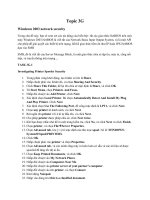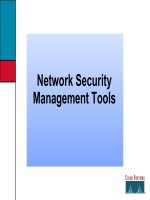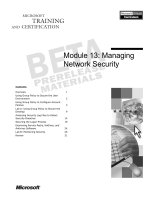Nmap network security scanner man page
Bạn đang xem bản rút gọn của tài liệu. Xem và tải ngay bản đầy đủ của tài liệu tại đây (158.17 KB, 18 trang )
Nmap network security scanner man page
NMAP(1) NMAP(1)
NAME
nmap - Network exploration tool and security scanner
SYNOPSIS
nmap [Scan Type(s)] [Options] <host or net #1 ... [#N]>
DESCRIPTION
Nmap is designed to allow system administrators and curi-
ous individuals to scan large networks to determine which
hosts are up and what services they are offering. nmap
supports a large number of scanning techniques such as:
UDP, TCP connect(), TCP SYN (half open), ftp proxy (bounce
attack), Reverse-ident, ICMP (ping sweep), FIN, ACK sweep,
Xmas Tree, SYN sweep, IP Protocol, and Null scan. See the
Scan Types section for more details. nmap also offers a
number of advanced features such as remote OS detection
via TCP/IP fingerprinting, stealth scanning, dynamic delay
and retransmission calculations, parallel scanning, detec-
tion of down hosts via parallel pings, decoy scanning,
port filtering detection, direct (non-portmapper) RPC
scanning, fragmentation scanning, and flexible target and
port specification.
Significant effort has been put into decent nmap perfor-
mance for non-root users. Unfortunately, many critical
kernel interfaces (such as raw sockets) require root priv-
ileges. nmap should be run as root whenever possible (not
setuid root, of course).
The result of running nmap is usually a list of interest-
ing ports on the machine(s) being scanned (if any). Nmap
always gives the port's "well known" service name (if
any), number, state, and protocol. The state is either
'open', 'filtered', or 'unfiltered'. Open means that the
target machine will accept() connections on that port.
Filtered means that a firewall, filter, or other network
obstacle is covering the port and preventing nmap from
determining whether the port is open. Unfiltered means
that the port is known by nmap to be closed and no fire-
wall/filter seems to be interfering with nmap's attempts
to determine this. Unfiltered ports are the common case
and are only shown when most of the scanned ports are in
the filtered state.
Depending on options used, nmap may also report the fol-
lowing characteristics of the remote host: OS in use, TCP
sequencability, usernames running the programs which have
bound to each port, the DNS name, whether the host is a
smurf address, and a few others.
OPTIONS
Options that make sense together can generally be com-
bined. Some options are specific to certain scan modes.
nmap tries to catch and warn the user about psychotic or
1
NMAP(1) NMAP(1)
unsupported option combinations.
If you are impatient, you can skip to the examples section
at the end, which demonstrates common usage. You can also
run nmap -h for a quick reference page listing all the
options.
SCAN TYPES
-sT TCP connect() scan: This is the most basic form of
TCP scanning. The connect() system call provided by
your operating system is used to open a connection
to every interesting port on the machine. If the
port is listening, connect() will succeed, other-
wise the port isn't reachable. One strong advantage
to this technique is that you don't need any spe-
cial privileges. Any user on most UNIX boxes is
free to use this call.
This sort of scan is easily detectable as target
host logs will show a bunch of connection and error
messages for the services which accept() the con-
nection just to have it immediately shutdown.
-sS TCP SYN scan: This technique is often referred to
as "half-open" scanning, because you don't open a
full TCP connection. You send a SYN packet, as if
you are going to open a real connection and you
wait for a response. A SYN|ACK indicates the port
is listening. A RST is indicative of a non-lis-
tener. If a SYN|ACK is received, a RST is immedi-
ately sent to tear down the connection (actually
our OS kernel does this for us). The primary advan-
tage to this scanning technique is that fewer sites
will log it. Unfortunately you need root privi-
leges to build these custom SYN packets.
-sF -sX -sN
Stealth FIN, Xmas Tree, or Null scan modes: There
are times when even SYN scanning isn't clandestine
enough. Some firewalls and packet filters watch for
SYNs to restricted ports, and programs like Synlog-
ger and Courtney are available to detect these
scans. These advanced scans, on the other hand, may
be able to pass through unmolested.
The idea is that closed ports are required to reply
to your probe packet with an RST, while open ports
must ignore the packets in question (see RFC 793 pp
64). The FIN scan uses a bare (surprise) FIN
packet as the probe, while the Xmas tree scan turns
on the FIN, URG, and PUSH flags. The Null scan
turns off all flags. Unfortunately Microsoft (like
usual) decided to completely ignore the standard
2
NMAP(1) NMAP(1)
and do things their own way. Thus this scan type
will not work against systems running Windows95/NT.
On the positive side, this is a good way to distin-
guish between the two platforms. If the scan finds
open ports, you know the machine is not a Windows
box. If a -sF,-sX,or -sN scan shows all ports
closed, yet a SYN (-sS) scan shows ports being
opened, you are probably looking at a Windows box.
This is less useful now that nmap has proper OS
detection built in. There are also a few other
systems that are broken in the same way Windows is.
They include Cisco, BSDI, HP/UX, MVS, and IRIX.
All of the above send resets from the open ports
when they should just drop the packet.
-sP Ping scanning: Sometimes you only want to know
which hosts on a network are up. Nmap can do this
by sending ICMP echo request packets to every IP
address on the networks you specify. Hosts that
respond are up. Unfortunately, some sites such as
microsoft.com block echo request packets. Thus
nmap can also send a TCP ack packet to (by default)
port 80. If we get an RST back, that machine is
up. A third technique involves sending a SYN
packet and waiting for a RST or a SYN/ACK. For
non-root users, a connect() method is used.
By default (for root users), nmap uses both the
ICMP and ACK techniques in parallel. You can
change the -P option described later.
Note that pinging is done by default anyway, and
only hosts that respond are scanned. Only use this
option if you wish to ping sweep without doing any
actual port scans.
-sU UDP scans: This method is used to determine which
UDP (User Datagram Protocol, RFC 768) ports are
open on a host. The technique is to send 0 byte
udp packets to each port on the target machine. If
we receive an ICMP port unreachable message, then
the port is closed. Otherwise we assume it is
open.
Some people think UDP scanning is pointless. I usu-
ally remind them of the recent Solaris rcpbind
hole. Rpcbind can be found hiding on an undocu-
mented UDP port somewhere above 32770. So it
doesn't matter that 111 is blocked by the firewall.
But can you find which of the more than 30,000 high
ports it is listening on? With a UDP scanner you
can! There is also the cDc Back Orifice backdoor
program which hides on a configurable UDP port on
Windows machines. Not to mention the many commonly
3
NMAP(1) NMAP(1)
vulnerable services that utilize UDP such as snmp,
tftp, NFS, etc.
Unfortunately UDP scanning is sometimes painfully
slow since most hosts impliment a suggestion in RFC
1812 (section 4.3.2.8) of limiting the ICMP error
message rate. For example, the Linux kernel (in
net/ipv4/icmp.h) limits destination unreachable
message generation to 80 per 4 seconds, with a 1/4
second penalty if that is exceeded. Solaris has
much more strict limits (about 2 messages per sec-
ond) and thus takes even longer to scan. nmap
detects this rate limiting and slows down accord-
ingly, rather than flood the network with useless
packets that will be ignored by the target machine.
As is typical, Microsoft ignored the suggestion of
the RFC and does not seem to do any rate limiting
at all on Win95 and NT machines. Thus we can scan
all 65K ports of a Windows machine very quickly.
Woop!
-sO IP protocol scans: This method is used to determine
which IP protocols are supported on a host. The
technique is to send raw IP packets without any
further protocol header to each specified protocol
on the target machine. If we receive an ICMP pro-
tocol unreachable message, then the protocol is not
in use. Otherwise we assume it is open. Note that
some hosts (AIX, HP-UX, Digital UNIX) and firewalls
may not send protocol unreachable messages. This
causes all of the protocols to appear "open".
Because the implemented technique is very similar
to UDP port scanning, ICMP rate limit might apply
too. But the IP protocol field has only 8 bits, so
at most 256 protocols can be probed which should be
possible in reasonable time anyway.
-sA ACK scan: This advanced method is usually used to
map out firewall rulesets. In particular, it can
help determine whether a firewall is stateful or
just a simple packet filter that blocks incoming
SYN packets.
This scan type sends an ACK packet (with random
looking acknowledgement/sequence numbers) to the
ports specified. If a RST comes back, the ports is
classified as "unfiltered". If nothing comes back
(or if an ICMP unreachable is returned), the port
is classified as "filtered". Note that nmap usu-
ally doesn't print "unfiltered" ports, so getting
no ports shown in the output is usually a sign that
all the probes got through (and returned RSTs).
4
NMAP(1) NMAP(1)
This scan will obviously never show ports in the
"open" state.
-sW Window scan: This advanced scan is very similar to
the ACK scan, except that it can sometimes detect
open ports as well as filtered/nonfiltered due to
an anomaly in the TCP window size reporting by some
operating systems. Systems vulnerable to this
include at least some versions of AIX, Amiga, BeOS,
BSDI, Cray, Tru64 UNIX, DG/UX, OpenVMS, Digital
UNIX, FreeBSD, HP-UX, OS/2, IRIX, MacOS, NetBSD,
OpenBSD, OpenStep, QNX, Rhapsody, SunOS 4.X,
Ultrix, VAX, and VxWorks. See the nmap-hackers
mailing list archive for a full list.
-sR RPC scan. This method works in combination with
the various port scan methods of Nmap. It takes
all the TCP/UDP ports found open and then floods
them with SunRPC program NULL commands in an
attempt to determine whether they are RPC ports,
and if so, what program and version number they
serve up. Thus you can effectively obtain the same
info as firewall (or protected by TCP wrappers).
Decoys do not currently work with RPC scan, at some
point I may add decoy support for UDP RPC scans.
-b <ftp relay host>
FTP bounce attack: An interesting "feature" of the
ftp protocol (RFC 959) is support for "proxy" ftp
connections. In other words, I should be able to
connect from evil.com to the FTP server of tar-
get.com and request that the server send a file
ANYWHERE on the internet! Now this may have worked
well in 1985 when the RFC was written. But in
today's Internet, we can't have people hijacking
ftp servers and requesting that data be spit out to
arbitrary points on the internet. As *Hobbit* wrote
back in 1995, this protocol flaw "can be used to
post virtually untraceable mail and news, hammer on
servers at various sites, fill up disks, try to hop
firewalls, and generally be annoying and hard to
track down at the same time." What we will exploit
this for is to (surprise, surprise) scan TCP ports
from a "proxy" ftp server. Thus you could connect
to an ftp server behind a firewall, and then scan
ports that are more likely to be blocked (139 is a
good one). If the ftp server allows reading from
and writing to some directory (such as /incoming),
you can send arbitrary data to ports that you do
find open (nmap doesn't do this for you though).
The argument passed to the 'b' option is the host
you want to use as a proxy, in standard URL nota-
tion. The format is:
5
NMAP(1) NMAP(1)
username:password@server:port. Everything but
server is optional. To determine what servers are
vulnerable to this attack, you can see my article
in Phrack 51. And updated version is available at
the nmap URL ( /> GENERAL OPTIONS
None of these are required but some can be quite
useful.
-P0 Do not try and ping hosts at all before scanning
them. This allows the scanning of networks that
don't allow ICMP echo requests (or responses)
through their firewall. microsoft.com is an exam-
ple of such a network, and thus you should always
use -P0 or -PT80 when portscanning microsoft.com.
-PT Use TCP "ping" to determine what hosts are up.
Instead of sending ICMP echo request packets and
waiting for a response, we spew out TCP ACK packets
throughout the target network (or to a single
machine) and then wait for responses to trickle
back. Hosts that are up should respond with a RST.
This option preserves the efficiency of only scan-
ning hosts that are up while still allowing you to
scan networks/hosts that block ping packets. For
non root users, we use connect(). To set the des-
tination port of the probe packets use -PT<port
number>. The default port is 80, since this port
is often not filtered out.
-PS This option uses SYN (connection request) packets
instead of ACK packets for root users. Hosts that
are up should respond with a RST (or, rarely, a
SYN|ACK).
-PI This option uses a true ping (ICMP echo request)
packet. It finds hosts that are up and also looks
for subnet-directed broadcast addresses on your
network. These are IP addresses which are exter-
nally reachable and translate to a broadcast of
incomming IP packets to a subnet of computers.
These should be eliminated if found as they allow
for numerous denial of service attacks (Smurf is
the most common).
-PB This is the default ping type. It uses both the
ACK ( -PT ) and ICMP ( -PI ) sweeps in parallel.
This way you can get firewalls that filter either
one (but not both).
-O This option activates remote host identification
via TCP/IP fingerprinting. In other words, it uses
a bunch of techniques to detect subtleties in the
6
NMAP(1) NMAP(1)
underlying operating system network stack of the
computers you are scanning. It uses this informa-
tion to create a 'fingerprint' which it compares
with its database of known OS fingerprints (the
nmap-os-fingerprints file) to decide what type of
system you are scanning.
If Nmap is unable to guess the OS of a machine, and
conditions are good (eg at least one open port),
Nmap will provide a URL you can use to submit the









